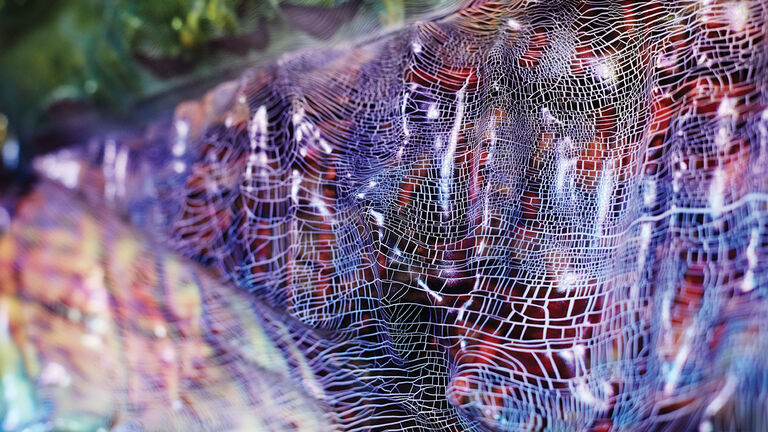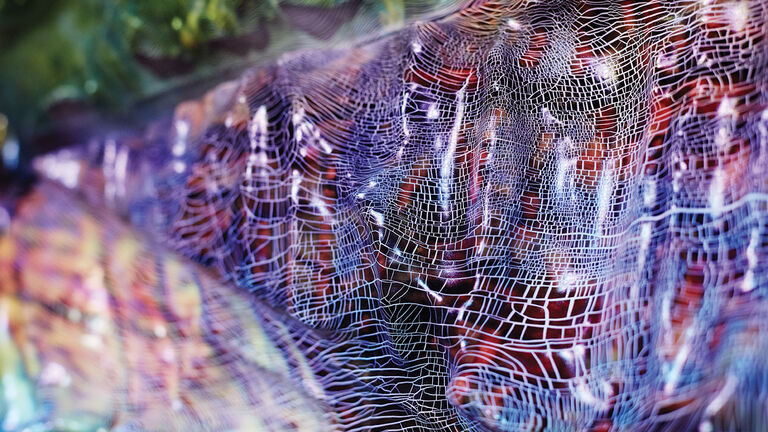
Undergraduate Overview
Visual Communication Design Undergraduate Overview
The Visual Communication Design department's undergraduate curriculum is structured to encourage the development of both generalized and specialized activities, as well as hybrids of both. Students acquire a thorough intellectual understanding of the implications, strategies, and roles of visual messages as well as the visual abilities necessary for conceptualization and creation and the technical tools and business skills required in professional practice.
Focus Areas
The major areas of focus are physical media (print, objects, and environments) and virtual media (interactive and time-based media) and include:
- Books/bookbinding
- Coding/programming/scripting
- Data visualization/diagrams/maps
- Design issues
- Film titles
- Fonts
- Identity systems
- Illustrations
- Image text narrative
- Installations/wayfinding signage
- Interface design
- Letterpress printing
- Methodologies
- Museum exhibitions/kiosks
- Packages/package graphics
- Posters
- Print production and offset printing
- Digital/screen-based production
- Publications/magazines
- Strategy
- Symbols/web icons
- Theory
- Typography
- Websites/design for mobile phone and tablets
- Video
Portfolio Review
Students must pass a Visual Communication Design department portfolio review in order to enroll in intermediate courses in the department. The following Visual Communication Design courses are required in order to submit a portfolio to the department Portfolio Review.
- VCD 1001 Introduction to Visual Communication
- VCD 1002 Illustration Technologies Lab
- VCD 2011 Beginning Typography
- VCD 2012 Type Technologies Lab
- VCD 2001 Beginning Graphic Design
- VCD 2002 Image Studio
Visual Communication Design Undergraduate Curriculum [PDF]
AIGA / CIPB
The department has an active AIGA (American Institute of Graphic Arts) student chapter. Led by a faculty member, the chapter holds regular meetings, hosts the department’s noon hour lectures in which professionals from the city and faculty from the department present their work, conducts tours of Chicago studios, holds an annual Town Hall AIGA event at the school, oversees a biannual portfolio preparation seminar for all students preparing their work for submission to the department portfolio review.
The department also has a relationship with the CIPB (Chicago International Poster Biennial), an international competition representing leading designers from throughout the world. Every two years, together with CIPB, the department holds a series of events including juror-led student workshops, entry jurying, and jurors’ lectures.
Admissions Requirements and Curriculum
-
To apply to the School of the Art Institute of Chicago (SAIC), you must fill out an application and submit your transcripts, artist's statement, and letters of recommendation. And most importantly, we require a portfolio of your best and most recent work—work that will give us a sense of you, your interests, and your willingness to explore, experiment, and think beyond technical art, design, and writing skills.
To apply, please submit the following items:
- Online application
- Artist’s Statement
- Transcripts
- Letter of Recommendation
- Test Scores
- Portfolio
Bachelor of Fine Arts in Studio Portfolio:
Submit 10–15 pieces of your best and most recent work. We will review your portfolio and application materials for merit scholarship once you have been admitted to SAIC.
When compiling a portfolio, you may concentrate your work in a single discipline or show work in a breadth of media. The portfolio may include drawings, prints, photographs, paintings, film, video, audio recordings, sculpture, ceramics, fashion designs, graphic design, furniture, objects, architectural designs, websites, video games, sketchbooks, scripts, storyboards, screenplays, zines, or any combination of the above.
Learn more about applying to SAIC's Bachelor of Fine Arts in Studio, or view our portfolio preparation guide for more information.
-
* BFA students must complete at least 6 credit hours in a class designated as "off campus study." These credits can also fulfill any of the requirements listed above and be from any of the divisions (Art History, Studio, Liberal Arts, or General Electives).
BFA With Distinction—SAIC Scholars Program: The SAIC Scholars program is a learning community of BFA students pursuing rigorous study in both their academic coursework and their studio pathways. There are two opportunities for interested students to apply to the SAIC Scholars Program: at the time of admission to the school, and after they have completed 30 credits of study at SAIC. Students pursuing the latter option are required to formally submit an application to the Undergraduate Division. Once admitted to the SAIC Scholars Program, students are required to successfully complete a minimum of six designated scholars courses. Students who complete the program will graduate with distinction.
Course Listing
BFA in Studio with Thesis Option (Liberal Arts or Visual Critical Studies)
BFA students may complete a nine-credit, research-based academic thesis as part of their studies within the 120 credits for the BFA in Studio degree. BFA with Thesis course sequences are offered over 3 semesters through the departments of Liberal Arts or Visual and Critical Studies (VCS). Students who are interested in one of the thesis options should follow the steps outlined below in the beginning of the junior year.
Requirements for the BFA: Studio Art with Liberal Arts Thesis
Step One: Students are required to meet with the Chair of the Liberal Arts department in the beginning of their junior year.
Step Two: With the Department Chair's approval, the student enrolls in the following courses beginning in the spring term of their junior year:
- SOCSCI or HUMANITY 3900 Academic Research and Writing (3 credits)
- LIBARTS 4800 Undergraduate Thesis: Research/Writing I (3 credits)
- CAPSTONE 4900 Liberal Arts Undergraduate Thesis: Research/Writing II (3 credits)
Step Three: The completed thesis must be approved by both the Thesis II instructor and the Chair of Liberal Arts. Students must make a formal presentation and participate in the Undergraduate Thesis Symposium in their senior year.
Requirements for the BFA: Studio Art with Visual and Critical Studies (VCS) Thesis
Step One: Students are required to meet with the Visual and Critical Studies Undergraduate Coordinator in or by the beginning of their junior year.
Step Two: With the VCS Coordinator's approval, the student enrolls in the first of the three-course sequence beginning in the spring term of their junior year:
- VCS 3010 Tutorial in Visual & Critical Studies (3 credits)
- VCS 4800 Undergraduate Thesis Seminar: Research & Writing I (3 credits)
- CAPSTONE 4900 VCS Undergraduate Thesis Seminar: Research & Writing II (3 credits)
Step Three: Completion of thesis must be approved by both the Thesis II instructor and the VCS Undergraduate Coordinator. Students must make a formal presentation and participate in the Undergraduate VCS Thesis Symposium in the senior year.
Take the Next Step
Visit the undergraduate admissions website or contact the undergraduate admissions office at 800.232.7242 or ugadmiss@saic.edu.
